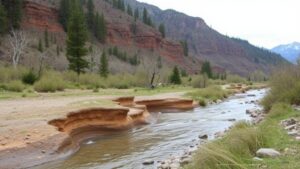The Role of Hydrothermal Alteration Zones in Gold and Silver Formation
The Role of Hydrothermal Alteration Zones in Gold and Silver Formation
The formation of gold and silver deposits is a complex geological process, intricately tied to hydrothermal systems. Hydrothermal alteration zones play a crucial role in the concentration of these precious metals, transforming the mineral landscape through various geological processes. This article aims to explore the significance of hydrothermal alteration zones in the formation of gold and silver deposits, supported by concrete examples and data.
Understanding Hydrothermal Alteration
Hydrothermal alteration refers to the physical and chemical changes that minerals undergo due to the interaction with hot, chemically active fluids. e fluids primarily originate from magmatic sources but can also be related to meteorological or groundwater processes. In the context of ore formation, hydrothermal fluids can dissolve and transport metals, eventually depositing them in concentrated deposits.
Mechanisms of Gold and Silver Deposition
The mechanisms by which gold and silver are deposited within hydrothermal systems include:
- Dissolution: Metals can be solubilized in aqueous solutions through various complexation reactions.
- Transport: Hydrothermal fluids carry the dissolved metals as they migrate through fractures and permeable rocks.
- Precipitation: Changes in temperature, pressure, or chemical composition can lead to supersaturation, resulting in metal deposition.
Types of Hydrothermal Alteration Zones
There are several types of hydrothermal alteration zones that significantly influence gold and silver mineralization:
- Silicification: This involves the replacement of rock minerals with silica, which traps gold and silver in its structure. It often forms around hydrothermal vents.
- Argillic Alteration: Characterized by the formation of clay minerals, this process can enhance the permeability of rocks, enabling metal migration and precipitation.
- Carbonate Alteration: The introduction of carbonates can facilitate the deposition of metal sulfides, particularly those associated with gold.
Case Studies in Hydrothermal Alteration
One prominent example of hydrothermal alteration leading to significant gold deposits is the Carlin Trend in Nevada, USA. Here, extensive hydrothermal systems have altered sedimentary rocks, resulting in the formation of large gold deposits through silicification and argillic alteration. Statistical records indicate that the Carlin Trend has produced over 87 million ounces of gold since mining began in the 1960s.
Another noteworthy case is the Sudbury Basin in Canada, known for both nickel and precious metal deposits. The intense hydrothermal activity here has led to the alteration of the surrounding rocks, which facilitated the concentration of silver deposits alongside other metals.
Geophysical and Geochemical Techniques
Identifying and characterizing hydrothermal alteration zones require advanced geophysical and geochemical techniques. Methods such as:
- Aerial Surveys: Used to identify surface alterations that may indicate underlying mineralization.
- Geochemical Sampling: Analyzing soil and water samples to detect metal anomalies associated with hydrothermal systems.
These techniques allow for the further exploration and understanding of potential gold and silver deposits, ultimately leading to successful mining operations.
Conclusion and Actionable Takeaways
Understanding the role of hydrothermal alteration zones in gold and silver formation is essential for mining companies and geologists aiming to explore ore deposits effectively. By recognizing the types of alterations and employing the correct techniques for identification, significant advancements can be made in locating new deposits. Key takeaways include:
- Hydrothermal fluids are instrumental in transporting and depositing gold and silver.
- Identifying hydrothermal alteration zones can facilitate more efficient mining exploration.
- The use of innovative geophysical and geochemical methodologies is crucial in modern mineral exploration.
